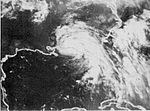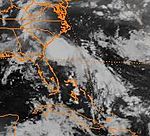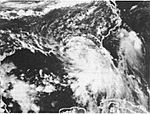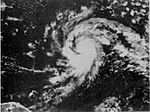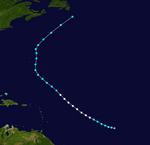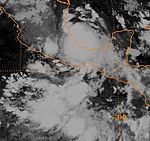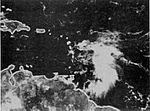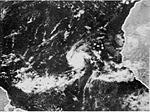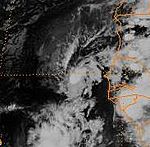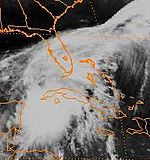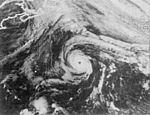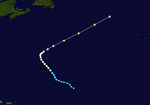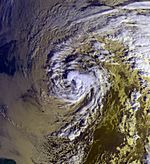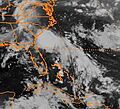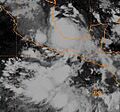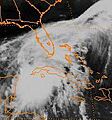Quick facts for kids
1994 Atlantic hurricane season
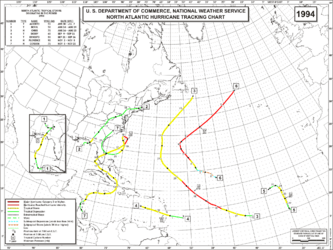 |
| First storm started: |
June 30 |
| Last storm ended: |
November 21 |
| Strongest storm: |
Hurricane Florence - 972 mbar, 110 mph winds |
| Number of storms: |
7 |
| Major hurricanes (Cat. 3+) |
0 |
| Cost of damage: |
$1.56 billon (1994 USD)
$2 billion (2008 USD) |
| People killed: |
Around 1,184 people |
| Closest seasons: |
1992, 1993, 1994, 1995, 1996 |
|
The 1994 Atlantic hurricane season was a special time from June 1 to November 30, 1994. This is when tropical storms and hurricanes usually form in the Atlantic Ocean. Even though storms can sometimes appear earlier or later, most happen during these months. In 1994, the last storm, Hurricane Gordon, ended on November 21. This was nine days before the official end of the season.
This season was unusual because it did not have any "major hurricanes." A major hurricane is a very strong storm, Category 3 or higher on the Saffir–Simpson Hurricane Scale. The strongest storm in 1994 was Hurricane Florence. It reached Category 2 with winds of 110 miles per hour (175 km/h). Only three storms became hurricanes: Chris, Florence, and Gordon. One of the most well-known storms from 1994 was Hurricane Gordon. This storm lasted a long time in November and sadly caused many deaths, especially in Haiti.
Storms of the 1994 Hurricane Season
|
Storms
|
|
|
|
| TS |
Ernesto |
| TD |
Eight |
| TD |
Nine |
|
|
|
Tropical Storm Alberto: A Wet Start
| Tropical storm (SSHS) |
|
|
| Duration |
June 30 – July 7 |
| Intensity |
65 mph (100 km/h) (1-min), 993 mbar (hPa) |
Tropical Storm Alberto started as a tropical depression on July 2. It formed north of the Yucatán Peninsula. Alberto moved north and hit land near Destin, Florida on July 3. It was a strong tropical storm when it made landfall.
After hitting Florida, Alberto quickly became weaker. It turned into a tropical depression and moved across Georgia and Alabama. The storm finally disappeared on July 7. Alberto caused about $500 million in damage. Sadly, 30 people lost their lives because of this storm.
Tropical Depression Two: A Quiet Storm
| Tropical depression (SSHS) |
|
|
| Duration |
July 20 – July 23 |
| Intensity |
35 mph (55 km/h) (1-min), 1015 mbar (hPa) |
Tropical Depression Two formed near South Carolina on July 19. It moved north and made landfall in South Carolina. The depression then disappeared on July 23. This storm did not cause any damage or deaths.
Tropical Storm Beryl: Bringing Inland Flooding
| Tropical storm (SSHS) |
|
|
| Duration |
August 14 – August 19 |
| Intensity |
60 mph (95 km/h) (1-min), 999 mbar (hPa) |
Beryl formed off the Florida Panhandle on August 15. Just twelve hours later, it hit land near Panama City, Florida. Beryl got stronger quickly before it made landfall. Its top winds reached 60 miles per hour.
As Beryl moved inland, it caused a lot of flooding in Georgia. It then moved across the Carolinas and all the way to Connecticut. There, another weather system absorbed it. Beryl caused about $73 million in damage. While it did not cause any deaths, many people were hurt. This was due to 37 tornadoes that Beryl created as it weakened.
Hurricane Chris: Brushing Bermuda
| Category 1 hurricane (SSHS) |
|
|
| Duration |
August 16 – August 23 |
| Intensity |
80 mph (130 km/h) (1-min), 979 mbar (hPa) |
Chris formed far out in the Atlantic Ocean on August 17. It was between the Lesser Antilles and Cape Verde. The next day, it became a hurricane. Chris moved northwest and then turned north. It passed by Bermuda on August 21 as a weak tropical storm. Chris continued north and disappeared without causing any damage.
Tropical Depression Five: Over Mexico
| Tropical depression (SSHS) |
|
|
| Duration |
August 29 – August 31 |
| Intensity |
35 mph (55 km/h) (1-min), 1005 mbar (hPa) |
A weather wave that later became Tropical Depression Five was watched starting on August 17. It became a depression on August 29 near the Yucatán Peninsula. Tropical Depression Five made landfall in Tampico, Mexico, on August 31. It disappeared over Mexico on the same day. This depression did not cause any damage.
Tropical Storm Debby: Impacting the Caribbean
| Tropical storm (SSHS) |
|
|
| Duration |
September 9 – September 11 |
| Intensity |
70 mph (110 km/h) (1-min), 1006 mbar (hPa) |
Tropical Storm Debby formed on September 10, just east of the Lesser Antilles. The storm moved across some of these islands. It then disappeared south of Puerto Rico on September 11. Sadly, nine people died because of Tropical Storm Debby. It caused flooding and mudslides in Saint Lucia. We do not have estimates for the total damage cost.
Tropical Storm Ernesto: A Storm at Sea
| Tropical storm (SSHS) |
|
|
| Duration |
September 21 – September 26 |
| Intensity |
60 mph (95 km/h) (1-min), 1000 mbar (hPa) |
Ernesto formed southwest of Cape Verde on September 22 and became Tropical Storm Ernesto. It moved north for two days. By September 24, it had weakened to a tropical depression. Two days later, Ernesto disappeared without affecting any land.
Tropical Depression Eight: Across Central America
| Tropical depression (SSHS) |
|
|
| Duration |
September 24 – September 26 |
| Intensity |
35 mph (55 km/h) (1-min), 1004 mbar (hPa) |
Tropical Depression Eight formed on September 19 in the southwestern Caribbean Sea. It became a tropical depression on September 24 near Honduras. Tropical Depression Eight made landfall in Mexico. It disappeared the next day over Guatemala. Some reports suggest that what was left of this storm later became Tropical Depression Ten.
Tropical Depression Nine: Near Cape Verde
| Tropical depression (SSHS) |
|
|
| Duration |
September 27 – September 29 |
| Intensity |
35 mph (55 km/h) (1-min), 1007 mbar (hPa) |
Tropical Depression Nine formed off the coast of Africa on September 26. It was upgraded to the ninth depression of the 1994 season. This happened about 150 miles southeast of the Cape Verde Islands the next day. The depression moved north and disappeared on September 29.
Tropical Depression Ten: Absorbed by Another System
| Tropical depression (SSHS) |
|
|
| Duration |
September 29 – September 30 |
| Intensity |
35 mph (55 km/h) (1-min), 1004 mbar (hPa) |
An area of stormy weather, connected to Tropical Depression Eight, moved across the northwest Caribbean Sea and the Yucatán Peninsula. A tropical wave moved into this area, causing more rain and clouds. This wave became Tropical Depression Ten on September 29. It was about 150 miles off the coast of Cuba. The system became better organized. When the depression moved into the Gulf of Mexico, another weather system absorbed it on September 30. Tropical Depression Ten caused about $5 million in damage.
Hurricane Florence: A Late-Season Hurricane
| Category 2 hurricane (SSHS) |
|
|
| Duration |
November 2 – November 8 |
| Intensity |
110 mph (175 km/h) (1-min), 972 mbar (hPa) |
Florence first formed as a subtropical depression in the central Atlantic on November 2. As it moved northwest, it gained tropical features. It was then upgraded to Tropical Storm Florence on November 4. It reached hurricane strength. Then, it turned northeast on November 6, picked up by a strong weather system. Two days later, Florence was absorbed by the same system that made it turn northeast. No damage was reported from this hurricane.
Hurricane Gordon: A Deadly and Tricky Storm
| Category 1 hurricane (SSHS) |
|
|
| Duration |
November 8 – November 21 |
| Intensity |
85 mph (140 km/h) (1-min), 980 mbar (hPa) |
Hurricane Gordon was a very deadly and damaging tropical storm. It affected the Caribbean, Florida, and parts of North Carolina. The storm moved very slowly as it traveled over the Caribbean. This slow movement made Hurricane Gordon very hard to predict. It was difficult to know where it would go and where it would hit land.
This storm caused over 1,100 deaths, especially in Haiti and other central Caribbean islands like Jamaica and Cuba. The damage from Gordon was estimated to be around $400 million.
Christmas 1994 Nor'easter: A Winter Storm
|
|
| Duration |
December 23 – December 24 |
| Intensity |
Winds unknown, 1007 mbar (hPa) |
Around Christmas in 1994, a strong winter storm called a nor'easter formed. It might have had some tropical features, but it was not officially called a tropical system. This storm affected the Mid-Atlantic and New England regions. It caused about $21 million in damage.
Images for kids
-
Tropical Storm Alberto's path.
-
Tropical Depression Two's path.
-
Tropical Storm Beryl's path.
-
-
Tropical Depression Five's path.
-
Tropical Storm Debby's path.
-
Tropical Storm Ernesto's path.
-
Tropical Depression Eight's path.
-
Tropical Depression Nine's path.
-
Tropical Depression Ten's path.
-
Hurricane Florence's path.
-
Hurricane Gordon on November 18, 1994.
|
Tropical cyclones of the 1994 Atlantic hurricane season
|
|
|
|
|
|
See also
 In Spanish: Temporada de huracanes en el Atlántico de 1994 para niños
In Spanish: Temporada de huracanes en el Atlántico de 1994 para niños

 In Spanish: Temporada de huracanes en el Atlántico de 1994 para niños
In Spanish: Temporada de huracanes en el Atlántico de 1994 para niños

